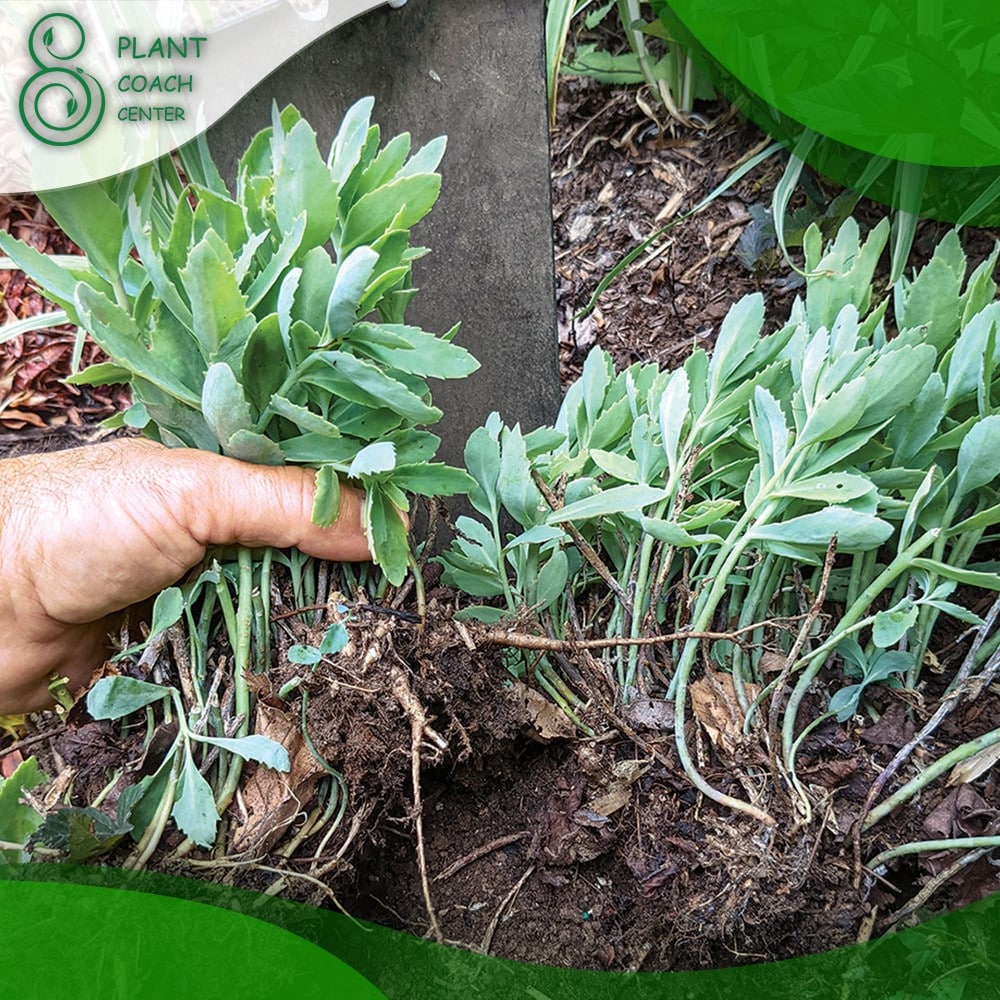When to Divide Sedum?
Welcome to the enchanting world of sedum cultivation, where nature’s resilience meets the gardener’s artistry. In gardening, few plants exhibit the tenacious beauty and adaptability of sedum. These hardy succulents, often called stonecrops, have captured the hearts of plant enthusiasts and landscapers alike with their captivating colors and remarkable ability to thrive in diverse conditions.
Yet, as these resilient wonders grace our gardens and living spaces, a question arises: When is the opportune moment to divide these botanical treasures? Just as sedum transforms its appearance with the shifting seasons, knowing the optimal time to divide these plants unveils a new dimension of gardening expertise. Join us on a journey through the seasons as we uncover the secrets of sedum division, decipher the signs they reveal, explore propagation techniques, and ensure their prosperous growth even after parting.
Whether you’re a seasoned horticulturist or just beginning your green-thumb adventures, this guide will illuminate the path to successful sedum division, where patience and understanding of nature’s rhythms yield rewards.
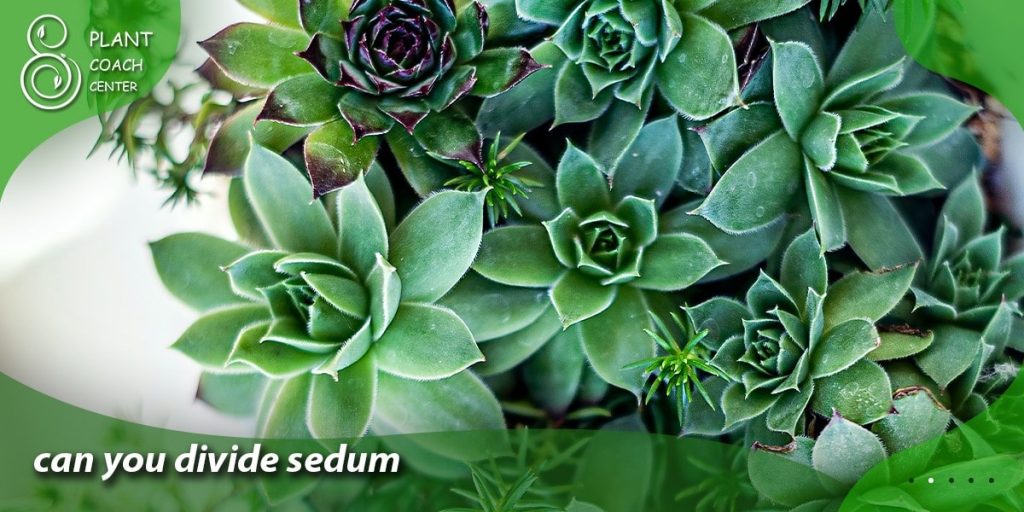
Seasonal Strategy: Timing the Split
Sedums, those resilient succulents that paint our landscapes with vivid hues, hold a fascinating relationship with the changing seasons. Understanding this dance between plant and environment is critical to mastering the art of dividing sedums. Spring emerges as a prime season for division as the sedum awakens from its winter slumber, ready to renew and spread its roots.
The plant’s energy surges as temperatures warm and daylight lengthens, making it more resilient to division stresses. Spring division sets the stage for rapid root establishment, allowing the new segments to anchor themselves before the harsh heat of summer.
Conversely, the tail end of summer carries its own allure for dividing sedums. As the growing season nears its close, sedums often display a surge of growth and vitality. Late summer division gives the freshly separated sedum a chance to establish its roots in the still-warm soil before the cooler months.
This strategic timing allows the plant to capitalize on the dwindling sunlight while minimizing the risk of root damage due to excessive heat. Additionally, gardeners in milder climates may find that the subtler shifts in temperature and moisture during late summer provide a conducive environment for successful division.
With its gentle transition into dormancy, fall also offers a window for dividing sedum. This period aligns with the plant’s natural preparation cycle for the colder months. By dividing sedum in early fall, you provide the plant ample time to establish roots and acclimate before winter’s arrival. The cooler temperatures and more consistent moisture levels in autumn create an environment conducive to new root growth, bolstering the resilience of your divided sedum as it braces for the impending frost.
In essence, each season whispers its own invitation for sedum division, each with unique advantages. Spring gifts us with rejuvenation and rapid establishment, late summer with the plant’s final burst of energy, and fall with its gentle yet determined preparation for winter’s embrace. By attuning ourselves to these seasonal nuances, we tap into the plant’s wisdom, ensuring that our sedum divisions survive and thrive, transforming our gardens into living, evolving works of art.
Signs of Sedum Readiness: Clues for Division
Gardening is an intricate dance between observation and action, and when it comes to dividing sedum, deciphering the plant’s signals is paramount. In its quiet ways, nature provides subtle cues that indicate the perfect moment for division. One of the most evident signs is overcrowding. As sedums flourish, they cluster and crowd together, competing for precious space and nutrients. When you notice the centers of the plants thinning out, it’s a telltale sign that division is on the horizon.
Another clue lies in the plant’s growth behavior. Sedums that were once compact and tight in their growth may start to show a looser, more sprawling habit. This change can indicate that the sedum is outgrowing its current confines and is ready to be separated to allow for healthier growth and airflow.
Pay attention to the health of the plant’s foliage as well. Sedums ready for division often exhibit sturdy, vibrant leaves with a firm texture. If you notice leaves becoming weak, discolored, or unusually small, it might indicate that the plant is struggling due to overcrowding.
Flowering patterns can also provide insights. When sedums that once produced abundant blooms begin to produce fewer or smaller flowers, it could be a sign that the plant’s resources are stretched thin, and division could revitalize its flowering potential.
Lastly, be attuned to the timing of your sedum’s growth cycle. Suppose you’ve been observing your sedum for multiple seasons and notice a consistent pattern of rapid growth followed by stagnation. In that case, it might indicate that the plant needs division to refresh its vigor.
By honing your observation skills and listening to the language of your sedums, you’ll be able to identify these subtle yet telling signs of readiness for division. Remember, the plant often speaks to us through its growth patterns, and being in tune with these cues enables you to steward its well-being, ensuring a flourishing and radiant garden.
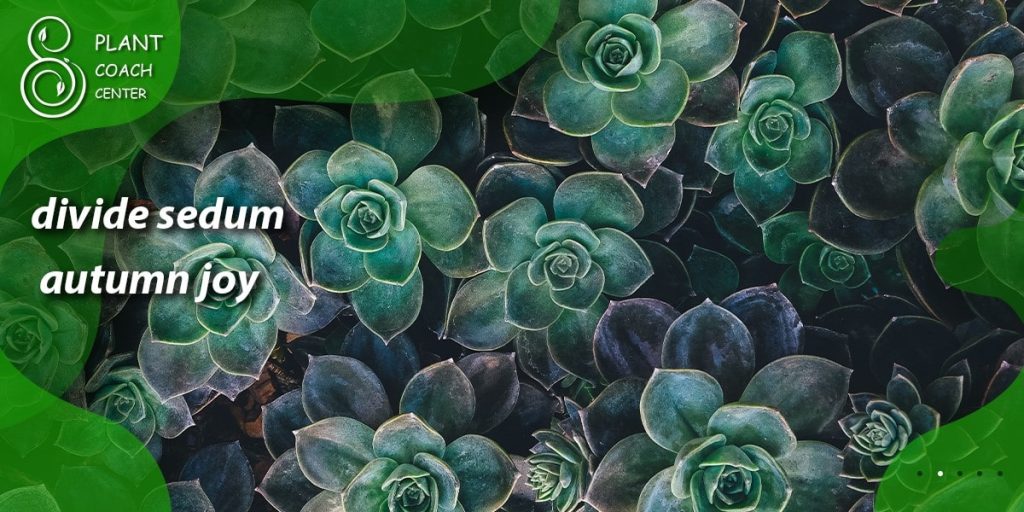
Propagation Play: Maximizing Success Through Division
Dividing sedums isn’t just about creating more plants; it’s about nurturing the future with care and precision. Propagation through division is a powerful technique that, when mastered, can lead to thriving plants and a flourishing garden. When you decide to divide your sedums, remember to start by preparing the new planting locations. Loosen the soil, enrich it with compost, and ensure proper drainage to set the stage for the sedum’s growth.
As you delicately separate the segments, ensure each division has an adequate root system and several healthy shoots. Trim any damaged or dead roots to encourage new growth. Before planting, give the divisions a brief opportunity to call us over. This practice helps reduce the risk of rot when freshly cut surfaces come into contact with the soil.
When placing the divisions in the ground, maintain appropriate spacing to allow for future growth. Gently thoroughly firm the soil around the roots and water to eliminate air pockets. Applying a layer of mulch can help retain moisture and stabilize soil temperature, further aiding the young sedum in establishing itself.
Post-division care is crucial. Keep a watchful eye on the newly separated sedums and water them regularly during the initial weeks. Gradually decrease the watering frequency as the plants acclimate, and roots grow deeper into the soil. A balanced fertilizer applied during the growing season can provide the essential nutrients for robust growth.
Remember, the art of propagation through division is both science and intuition. It’s a dance between the plant’s intrinsic tendencies and the gardener’s attentive touch. With each division, you’re not merely splitting a plant but crafting its future. By meticulously following these steps and allowing nature to work its magic, you ensure that your divided sedums flourish and contribute their vibrant beauty to your garden’s tapestry.
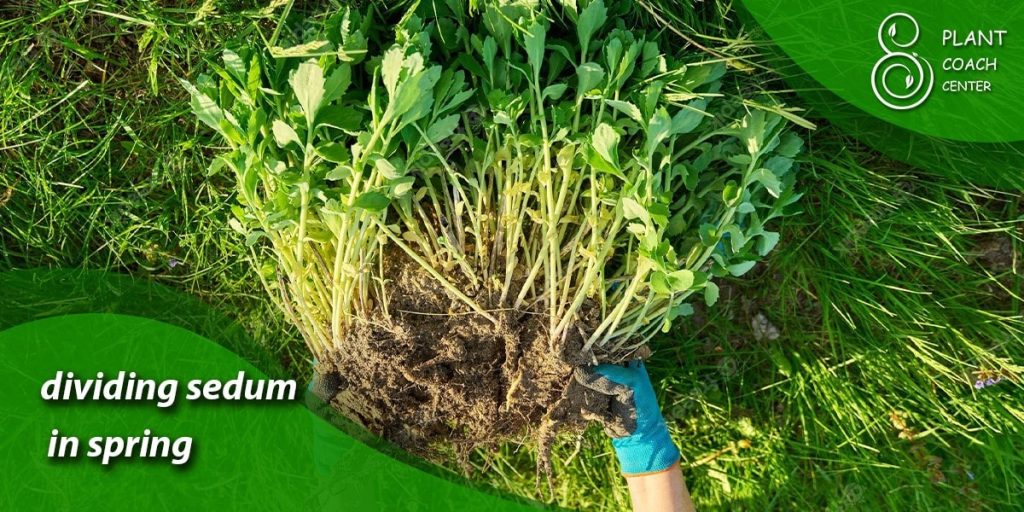
Dividing Techniques Demystified: From Clumps to Cuttings
When it comes to dividing sedums, there’s more than one way to partake in the propagation play. Your chosen techniques depend on your preferences, the sedum variety, and the desired outcome. Let’s unravel the mystery behind these techniques and explore how each contributes to the art of division.
Clump Division
This classic method separates the sedum’s root clumps into individual segments. Start by carefully digging up the entire plant clump. Gently shake off excess soil to expose the root structure. Divide the clump into smaller sections using your hands or a sharp knife, ensuring that each section has healthy roots and shoots. This technique works well for larger sedum varieties that have developed dense root systems.
Stem Cutting Division
This technique can be particularly effective if you’re working with sedum varieties with long stems. Select healthy stems with a few leaves attached and cut them into sections. Allow the cut ends to callus for a day or two before planting them in well-prepared soil. This method creates multiple plants from a single stem, quickly expanding your sedum collection.
Leaf Cutting Division
Some sedum varieties can be propagated using individual leaves. Gently pluck healthy leaves from the parent plant and allow them to air dry for a day or two to form calluses. Plant the callused end of the leaf into the soil, burying it slightly. Over time, the leaf will send out roots and new shoots, gradually transforming into a new sedum plant.
Root Division
Root division can be a viable option for sedums with a more extensive root network. Carefully dig up the plant and gently separate the roots into sections. Each section should have a portion of the root system and some shoots. Replant the divisions in well-prepared soil and provide proper care to encourage their growth.
Climate Considerations: Division in Different Zones
The art of dividing sedums doesn’t exist in a vacuum; it’s intimately connected to the environment in which your garden thrives. Different climate zones present unique challenges and opportunities for successful division. Let’s explore how varying climates influence the timing and techniques of dividing sedums.
Cold Climate Zones (Zone 3-6)
Timing is crucial in regions where winter temperatures drop significantly. Dividing sedums in early spring, just as the ground thaws, provides the best chance for the new divisions to establish roots before the frost returns. It’s advisable to choose hardier sedum varieties that can withstand colder temperatures. Late summer division can also work well, allowing the sedums to establish roots before the winter freeze.
Moderate Climate Zones (Zone 7-8)
Gardeners in moderate climates have the luxury of more flexible division timelines. Spring and late summer remain ideal windows for division, with sedums benefiting from the warm temperatures and longer growing seasons. However, monitoring the moisture levels is essential, as sedums in these zones might require more attention during the drier months.
Warm Climate Zones (Zone 9-11)
Division in warm climates requires careful consideration of the intense heat. Early spring or late summer division is preferred, as these seasons offer milder temperatures that reduce stress on the newly divided sedums. Adequate shading during the hottest parts of the day and consistent moisture are essential to prevent heat stress during the establishment phase.
In all climates, soil quality, and drainage play a critical role in the success of sedum division. Amending the soil with compost and ensuring proper drainage help create an environment where new divisions can thrive. Additionally, mulching the soil after division can aid in retaining moisture and stabilizing temperature fluctuations.
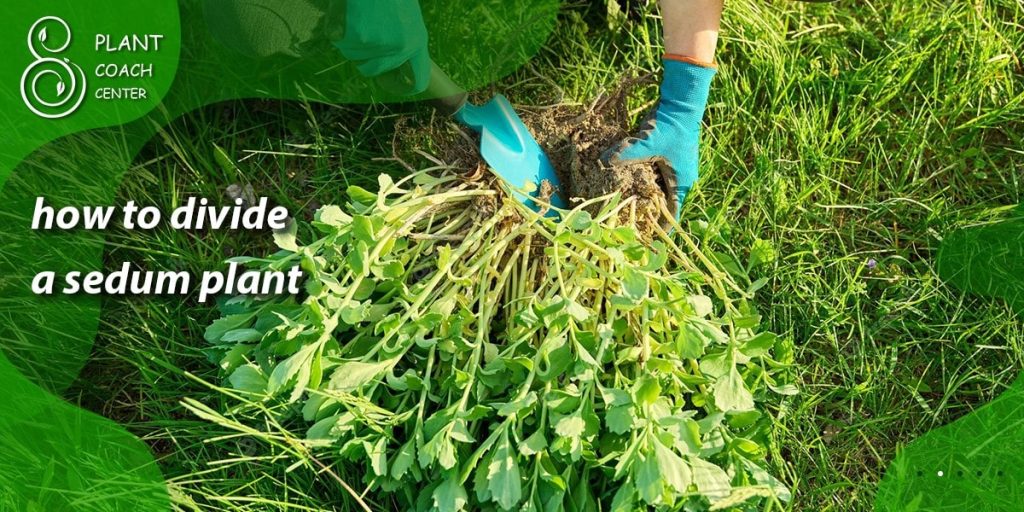
Post-Division TLC: Nurturing Your Newly Separated Sedum
As you bid farewell to the divisions you’ve carefully created, your role as a guardian is far from over. Immediately after division is a critical phase in the sedum’s journey, requiring your nurturing touch and vigilant care. Here’s how to provide the post-division TLC that ensures your newly separated sedums thrive.
Watering Wisdom
Hydration is vital during the initial weeks. Keep the soil consistently moist but not waterlogged. Use a gentle watering approach to prevent dislodging the new roots. As the sedums establish themselves, they gradually reduce the watering frequency, allowing the roots to seek deeper moisture in the soil.
Sunlight and Shade
Balance is essential regarding sun exposure. While sedums love sunlight, newly divided plants can be sensitive to intense rays. Gradually acclimate them to sunlight by providing some shade during the hottest parts of the day. Over time, increase their exposure to sunlight, allowing them to build their tolerance.
Gentle Fertilization
While it’s tempting to boost growth with excessive fertilization, restraint is advised. Begin with a balanced, diluted fertilizer during the growing season. Over-fertilization can stress the plants and lead to leggy growth or weakened roots.
Monitoring and Pruning
Regularly inspect your divided sedums for signs of stress, disease, or pest infestations. Prune away any damaged or dead foliage to promote healthy growth. Promptly address any issues to prevent them from spreading to the rest of your garden.
Mulching Magic
Apply a layer of organic mulch around the base of the newly divided sedums. Mulch helps retain moisture, regulate soil temperature, and suppress weeds, creating an optimal environment for root development.
Patience Pays
Remember that growth takes time. It’s normal for newly divided sedums to adjust before they resume vigorous growth. Be patient and continue to provide the care they need.
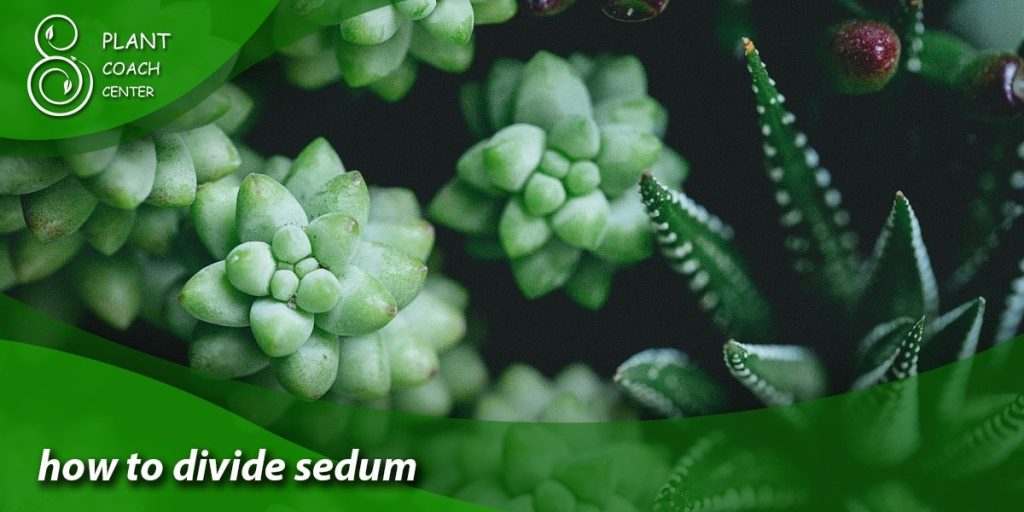
Conclusion
In the ever-evolving choreography of gardening, dividing sedums emerges as a dance of transformation and renewal. Each season presents an opportunity to engage with these hardy succulents, decoding their signals and nurturing their growth through careful division.
As we’ve explored the nuances of timing, techniques, and climate considerations, it’s evident that this art is a dialogue between nature’s rhythm and our attentive touch. Whether gazing at the frost-kissed landscapes of colder zones or embracing the perpetual warmth of tropical zones, the wisdom of sedum division adapts to every corner of our diverse world.
So, fellow gardeners, let us continue this journey with our newly divided sedums, understanding that with each act of division, we cultivate the present and invest in the garden’s future. For more insights, tips, and all things plant-related, visit PlantCouchCenter.com, where your passion for greenery finds its digital sanctuary.
When is the best time to divide sedum?
Spring or late summer for most zones.
How do I know if my sedum is ready for division?
Thinning centers, looser growth, and weaker leaves are signs.
What's the key to successful sedum division?
Attentive care post-division and understanding your climate's nuances.


